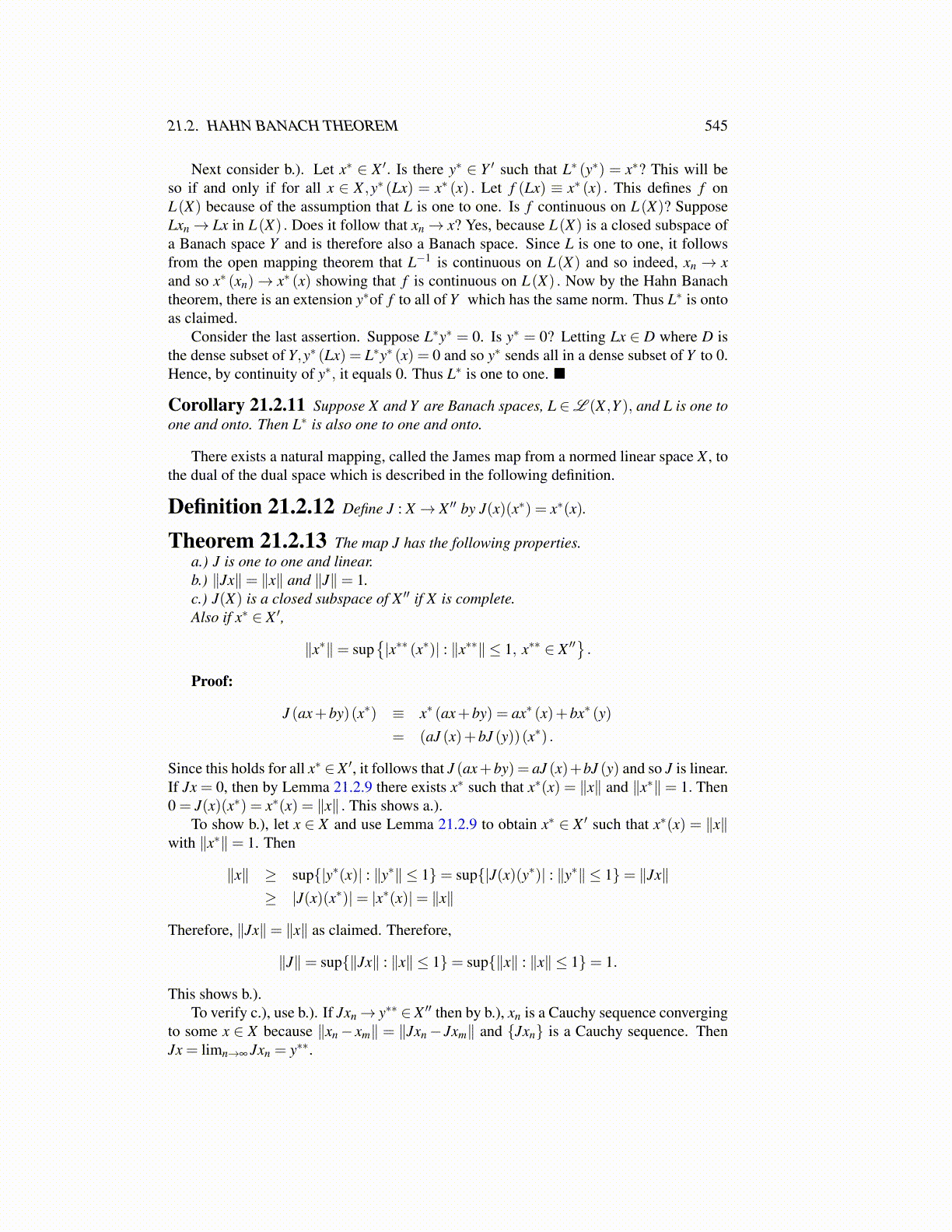
21.2. HAHN BANACH THEOREM 545
Next consider b.). Let x∗ ∈ X ′. Is there y∗ ∈ Y ′ such that L∗ (y∗) = x∗? This will beso if and only if for all x ∈ X ,y∗ (Lx) = x∗ (x) . Let f (Lx) ≡ x∗ (x) . This defines f onL(X) because of the assumption that L is one to one. Is f continuous on L(X)? SupposeLxn→ Lx in L(X) . Does it follow that xn→ x? Yes, because L(X) is a closed subspace ofa Banach space Y and is therefore also a Banach space. Since L is one to one, it followsfrom the open mapping theorem that L−1 is continuous on L(X) and so indeed, xn → xand so x∗ (xn)→ x∗ (x) showing that f is continuous on L(X) . Now by the Hahn Banachtheorem, there is an extension y∗of f to all of Y which has the same norm. Thus L∗ is ontoas claimed.
Consider the last assertion. Suppose L∗y∗ = 0. Is y∗ = 0? Letting Lx ∈ D where D isthe dense subset of Y,y∗ (Lx) = L∗y∗ (x) = 0 and so y∗ sends all in a dense subset of Y to 0.Hence, by continuity of y∗, it equals 0. Thus L∗ is one to one. ■
Corollary 21.2.11 Suppose X and Y are Banach spaces, L ∈L (X ,Y ), and L is one toone and onto. Then L∗ is also one to one and onto.
There exists a natural mapping, called the James map from a normed linear space X , tothe dual of the dual space which is described in the following definition.
Definition 21.2.12 Define J : X → X ′′ by J(x)(x∗) = x∗(x).
Theorem 21.2.13 The map J has the following properties.a.) J is one to one and linear.b.) ∥Jx∥= ∥x∥ and ∥J∥= 1.c.) J(X) is a closed subspace of X ′′ if X is complete.Also if x∗ ∈ X ′,
∥x∗∥= sup{|x∗∗ (x∗)| : ∥x∗∗∥ ≤ 1, x∗∗ ∈ X ′′
}.
Proof:
J (ax+by)(x∗) ≡ x∗ (ax+by) = ax∗ (x)+bx∗ (y)
= (aJ (x)+bJ (y))(x∗) .
Since this holds for all x∗ ∈ X ′, it follows that J (ax+by) = aJ (x)+bJ (y) and so J is linear.If Jx = 0, then by Lemma 21.2.9 there exists x∗ such that x∗(x) = ∥x∥ and ∥x∗∥= 1. Then0 = J(x)(x∗) = x∗(x) = ∥x∥ . This shows a.).
To show b.), let x ∈ X and use Lemma 21.2.9 to obtain x∗ ∈ X ′ such that x∗(x) = ∥x∥with ∥x∗∥= 1. Then
∥x∥ ≥ sup{|y∗(x)| : ∥y∗∥ ≤ 1}= sup{|J(x)(y∗)| : ∥y∗∥ ≤ 1}= ∥Jx∥≥ |J(x)(x∗)|= |x∗(x)|= ∥x∥
Therefore, ∥Jx∥= ∥x∥ as claimed. Therefore,
∥J∥= sup{∥Jx∥ : ∥x∥ ≤ 1}= sup{∥x∥ : ∥x∥ ≤ 1}= 1.
This shows b.).To verify c.), use b.). If Jxn→ y∗∗ ∈ X ′′ then by b.), xn is a Cauchy sequence converging
to some x ∈ X because ∥xn− xm∥ = ∥Jxn− Jxm∥ and {Jxn} is a Cauchy sequence. ThenJx = limn→∞ Jxn = y∗∗.